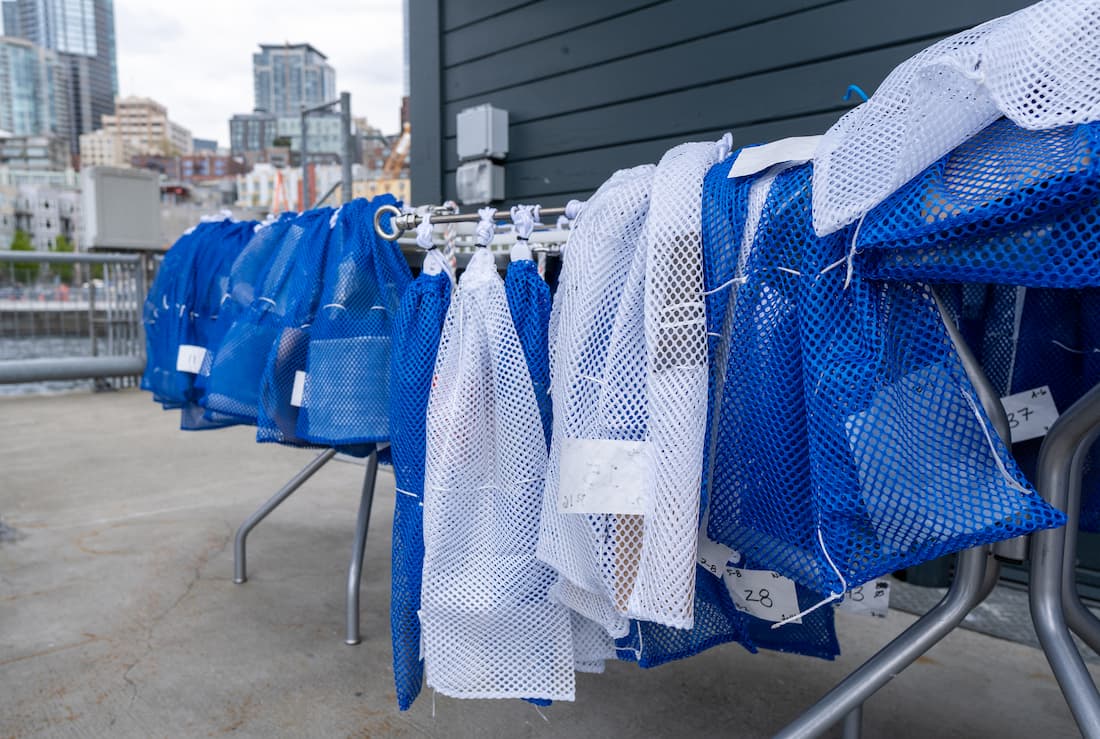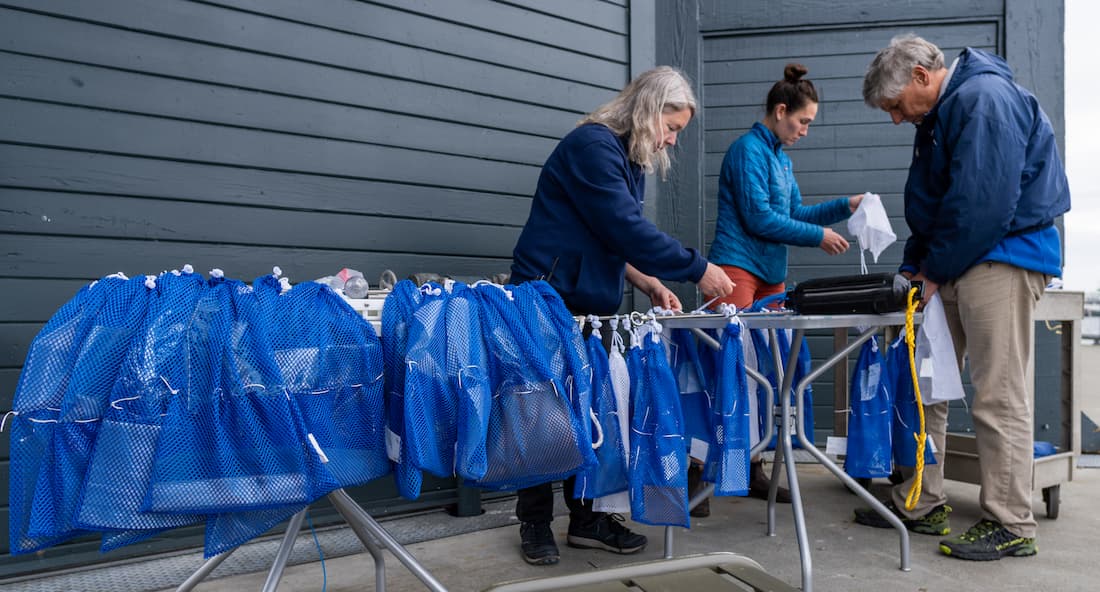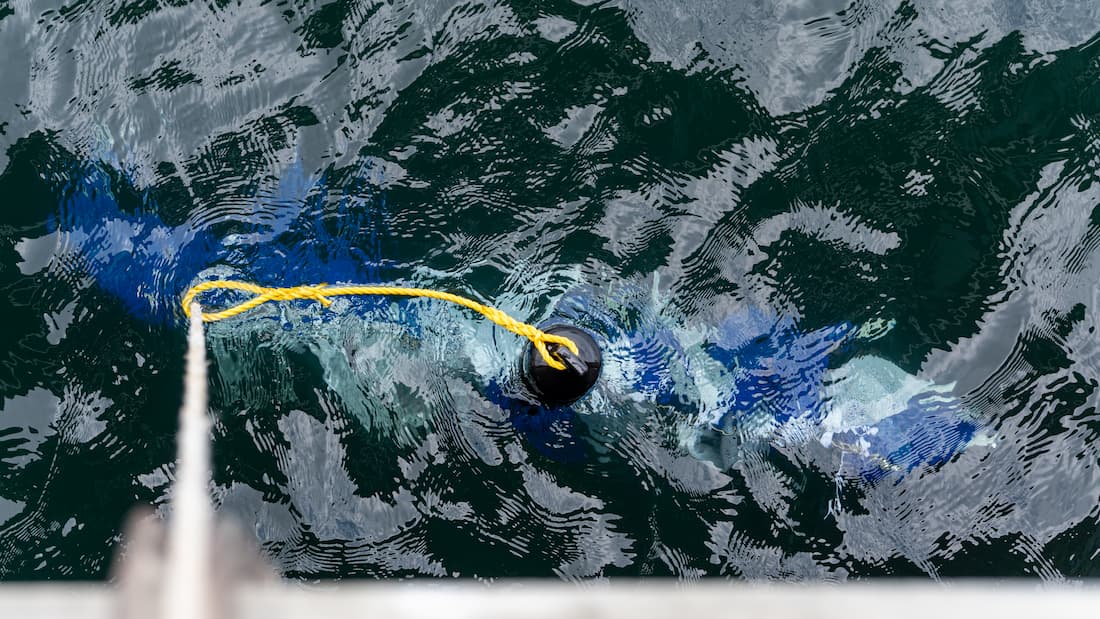
The Clean Seas Research Program at the Seattle Aquarium is thrilled to announce the start of environmental testing and our role as scientists and one of two testing sites for The TOM FORD Plastic Innovation Prize powered by Lonely Whale.
Single-use plastic films used for packaging, produce wrap and to-go bags make up 5 million metric tons, or ~46%, of all ocean plastic. These thin films are nearly impossible to recycle, and as such, are used once before throwing away (hence the term “single-use”). Replacing plastic films with more sustainable, nontoxic alternatives is an essential step toward “turning off the tap” of our plastic film pollution problem.
The TOM FORD Plastic Innovation Prize (PIP) is catalyzing the development of innovative, market-ready replacements for thin-film plastic. Through partnering with Lonely Whale and New Materials Institute, the Seattle Aquarium is excited to scientifically assess alternatives to plastic films. Eight finalists were selected to produce their plastic film alternative products to undergo a series of environmental exposure and lab-based tests. These tests will help the scientific advisory board determine which product both meets our consumer needs for plastics (like durability and flexibility) yet undergoes quick and safe degradation in environmental conditions.
Scientific approach
The Seattle Aquarium’s team of marine plastic scientists are poised to implement product testing in temperate waters (cooler, more northern waters which experience little temperature change), which represent the vast majority of marine waters. This is exciting as it’s the first time alternative plastics have been tested in colder waters. In addition, while products will be exposed to both temperate and Caribbean waters (facilitated by New Materials Institute), at the Seattle Aquarium we are carrying out an additional and novel laboratory test: Exposure to a gray whale’s stomach.

Now, you may be (correctly) thinking, “You’re feeding whales plastic film alternatives?!? That can’t be safe!” But there’s more to the story. Using our new Clean Seas Research Lab, we’re able to simulate a gray whale gut without harm to any animals. There are four basic ingredients to mimicking a gray whale gut: heat, acid, enzymes and agitation. Over the course of eight months, plastic film alternative products will hang below the Aquarium in temperate waters, be retrieved at pre-determined timepoints, and be exposed to a simulated whale gut to assess how environmental exposure affects digestive degradation and physical properties. Both before and after the simulated gut exposure, products will be assessed in four tests: 1) tensile strength (breaking point under stress), 2) mass loss, 3) estrogenicity (containing chemicals that mimic or disrupt naturally occurring estrogen that may cause endocrine disruptors), and 4) electrical resistance (how readily electricity passes through materials). This series of tests is the first of its kind to assess how products degrade if ingested after being in saltwater for varying amounts of time.

Stepping away from single-use plastics
Plastic films are durable, flexible and, importantly, inexpensive. These traits are some of the reasons why they’re used in abundance. While it’s best to avoid buying and consuming single-use plastics, we recognize it can be difficult to do so completely. When walking into a store or receiving a package from an online order, you’ll notice nearly everything is wrapped in plastic. In some instances, you’re not given a choice, and avoiding single-use or plastic films isn’t possible. To fully “turn off the tap” of our plastic pollution problem, both consumers as well as producers must take sustainable steps forward.
The Seattle Aquarium advocates for reducing the production of single-use plastics in the first place, such as by transitioning to reusable packaging alternatives. However, where films are necessary, companies must adopt sustainable, nontoxic, Earth- and ocean-friendly alternatives.
The TOM FORD Plastic Innovation Prize Early Adopter Coalition, consisting of several global companies (Nike, J. Crew, MillerKnoll and others), has committed to test plastic-alternative products in their supply chain to permanently eliminate their use of plastic film. From the scientific tests performed on products at the Seattle Aquarium focusing on biological degradation at end-of-life performance, we hope to better understand what types of material can meet society’s need for durable, flexible and degradable films and move toward turning off the tap.

You can make a difference now
This project is one step of many toward supply chain and single-use plastic waste reduction. As an individual, you can easily reduce single-use plastics—and here are just a few ways:
- Pick up litter on a local beach or, better yet, organize a group of friends or family members to join a local beach cleanup!
- Switch to reusable dishes and utensils. Bring your own reusable mug or bottle when you get coffee or water. Skip the plastic utensils and straws when you get takeout food.
- Choose products with less packaging. Pay attention to how much incidental plastic comes with what you buy—your candy, headphones, pens and more come in plastic packaging. Strive to cut down on your daily plastic consumption, buy used instead of new whenever possible and reward corporations that package responsibly!
- Buy in bulk rather than individually packaged items (some stores in the Seattle area allow personal containers, like Mason jars, for bulk products including grains and spices).
- Shop local to reduce shipping and packaging plastics.
- Find your congressional representative and urge them to co-sponsor the Reducing Waste in National Parks Act (H.R.5533) to eliminate the sale and distribution of single-use plastics—including plastic bottles, bags and food containers—in national parks across the country.
- Urge your senators to support the Plastic Pellet-Free Waters Act (S.1507) to keep plastic pellets out of the environment.
Find out more about how to get involved with plastic policies at our online Act for the Ocean page.
